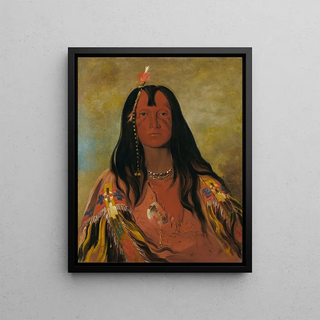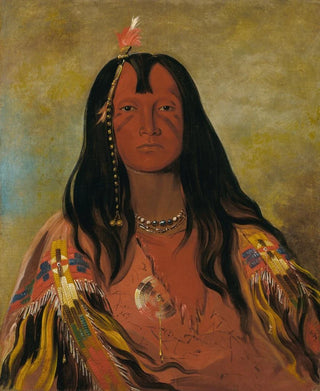Art print | Hco-A-Hco-A-Hcotes-Min No horns on the head a brave - George Catlin


View from behind

Frame (optional)
Art print Hco-A-Hco-A-Hcotes-Min No horns on the head, a brave - George Catlin – Captivating introduction
In the rich and fascinating universe of art, every work tells a story, a meeting between the artist and their subject. "Hco-A-Hco-A-Hcotes-Min No horns on the head, a brave" by George Catlin is one of those creations that transcend the simple frame to immerse us in a time and culture often little known. Catlin, as a pioneer of Native American painting, captured the very essence of indigenous peoples of North America, and this work is a perfect example. Through his brushstrokes, he invites us to explore a world where spirituality and daily life intertwine, while preserving a cultural memory threatened by colonial expansion.
Style and uniqueness of the work
The work stands out for its bold use of color and light, as well as for the precision of its details. Catlin, with a keen sense of observation, depicts his subject with such liveliness that it almost seems to come to life before our eyes. The character depicted, without horns on the head, is highlighted by a background that evokes the vast and majestic landscapes of the American West. The proud posture and traditional attire of the brave testify to a strong and resilient cultural identity. Every element of the composition, from clothing patterns to facial expressions, is carefully thought out to convey a palpable emotion. Catlin does not merely reproduce reality; he interprets it, infusing it with a depth that resonates with the viewer and invites reflection on the issues of representation.
The artist and his influence
George Catlin, born in 1796, is often considered the first artist to dedicate his career to the representation of Native American cultures. His work is the result of a passion for cultural diversity and a deep commitment to preserving these traditions. At a time when stories of indigenous peoples were often distorted or ignored, Catlin chose to give a voice to those in danger of being forgotten. His influence extends well beyond his era, inspiring many artists and historians to explore and value

Matte finish

View from behind

Frame (optional)
Art print Hco-A-Hco-A-Hcotes-Min No horns on the head, a brave - George Catlin – Captivating introduction
In the rich and fascinating universe of art, every work tells a story, a meeting between the artist and their subject. "Hco-A-Hco-A-Hcotes-Min No horns on the head, a brave" by George Catlin is one of those creations that transcend the simple frame to immerse us in a time and culture often little known. Catlin, as a pioneer of Native American painting, captured the very essence of indigenous peoples of North America, and this work is a perfect example. Through his brushstrokes, he invites us to explore a world where spirituality and daily life intertwine, while preserving a cultural memory threatened by colonial expansion.
Style and uniqueness of the work
The work stands out for its bold use of color and light, as well as for the precision of its details. Catlin, with a keen sense of observation, depicts his subject with such liveliness that it almost seems to come to life before our eyes. The character depicted, without horns on the head, is highlighted by a background that evokes the vast and majestic landscapes of the American West. The proud posture and traditional attire of the brave testify to a strong and resilient cultural identity. Every element of the composition, from clothing patterns to facial expressions, is carefully thought out to convey a palpable emotion. Catlin does not merely reproduce reality; he interprets it, infusing it with a depth that resonates with the viewer and invites reflection on the issues of representation.
The artist and his influence
George Catlin, born in 1796, is often considered the first artist to dedicate his career to the representation of Native American cultures. His work is the result of a passion for cultural diversity and a deep commitment to preserving these traditions. At a time when stories of indigenous peoples were often distorted or ignored, Catlin chose to give a voice to those in danger of being forgotten. His influence extends well beyond his era, inspiring many artists and historians to explore and value






